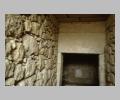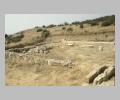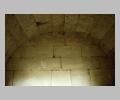
Early Christian basilicas, Amphipolis.
| Summary: | A major city, deriving its wealth from the gold mines of Mt. Pangaion. |
| Type: | Fortified city |
| Region: | Macedonia |
Periods:
Classical
Hellenistic
Roman
Byzantine
Physical:
Amphipolis is W of Kavalla, ca. 4 km N of the coast on the bank of the Strymon river. It was built on a commanding plateau 154 m above the river which curves around below the W half of the city walls. The fortification walls extend in a circuit of ca. 7 km and there is an inner acropolis wall of ca. 2 km. Excavations have uncovered domestic buildings of the Hellenistic and Roman periods, a Roman stoa and a number of Byzantine basilicas, but the agora, temples, and other structures of the Classical period remain to be discovered. Outside the walls 2 sanctuaries and a large number graves have been discovered.
Description:
In 437 B.C. Agnon defeated the local Edonians and established Amphipolis as an Athenian colony. The mixed population surrendered easily to Sparta in 424 B.C., but Athens retained control of its port city of Eion. Despite repeated efforts by the Athenians, Amphipolis remained autonomous until 357 B.C. when it was conquered by Philip II. During Alexander's campaign to Asia in 334 B.C., the city used as a naval base and Alexander's 3 most celebrated admirals were natives of Amphipolis. In the Hellenistic period it was the location of one of the royal mints. Rome conquered the city in 168 B.C. Prosperity continued through the Roman period and the international Via Egnatia passed through the city. During the Byzantine period the city was called Popolia and a large number of rich churches were constructed. The city was probably destroyed in the 9th century A.D. Slavic invasions.
Exploration:
Excavations since 1956 by the Greek Archaeological Service
Sources Used:
Other Bibliography:




